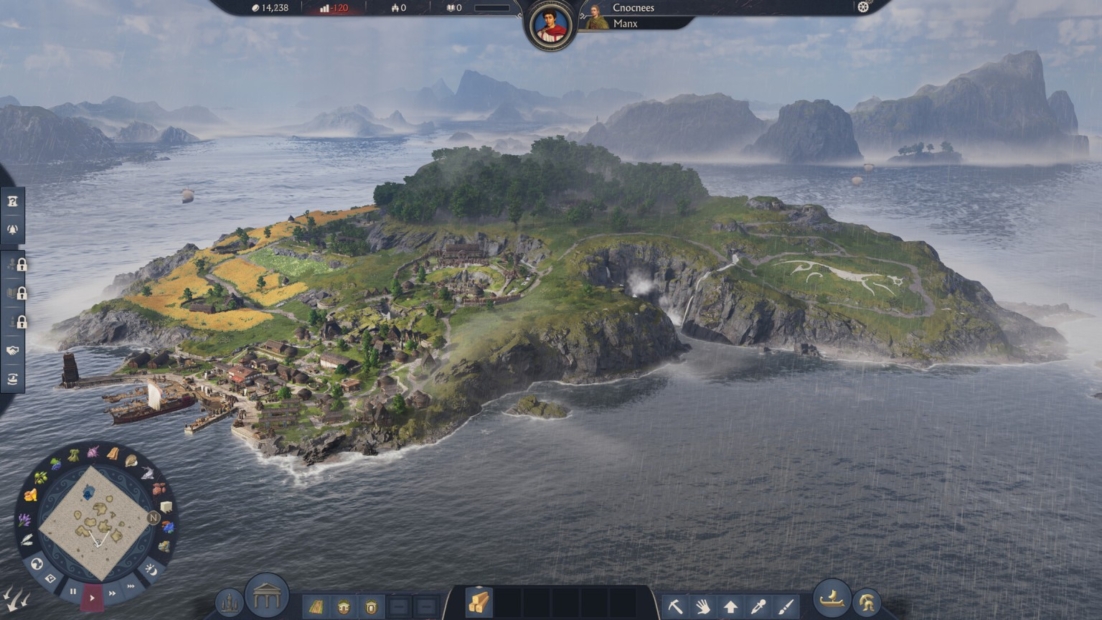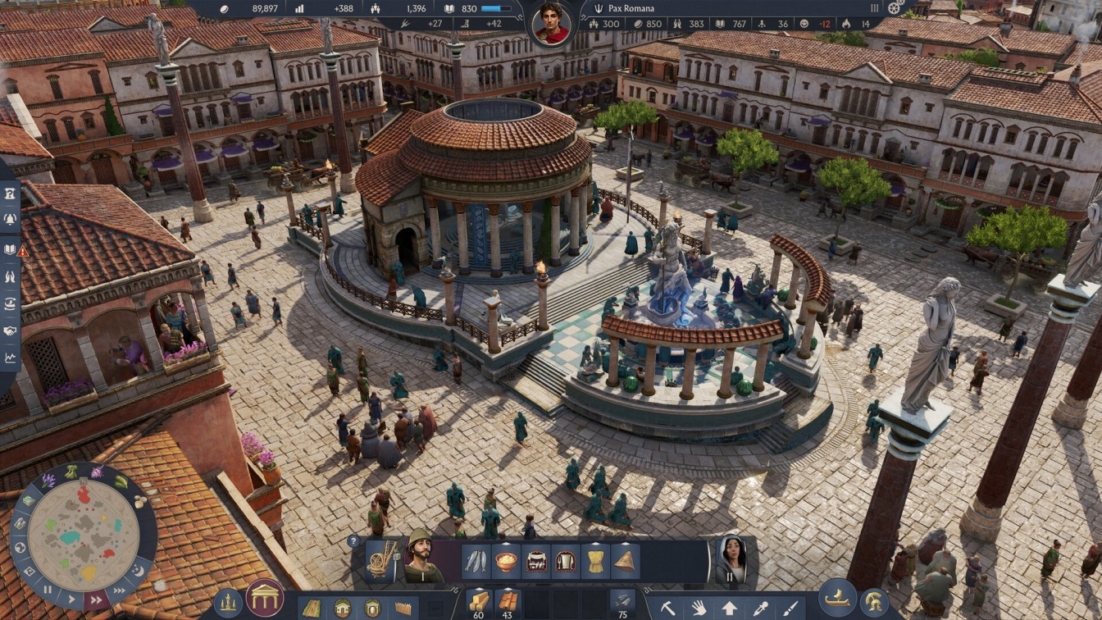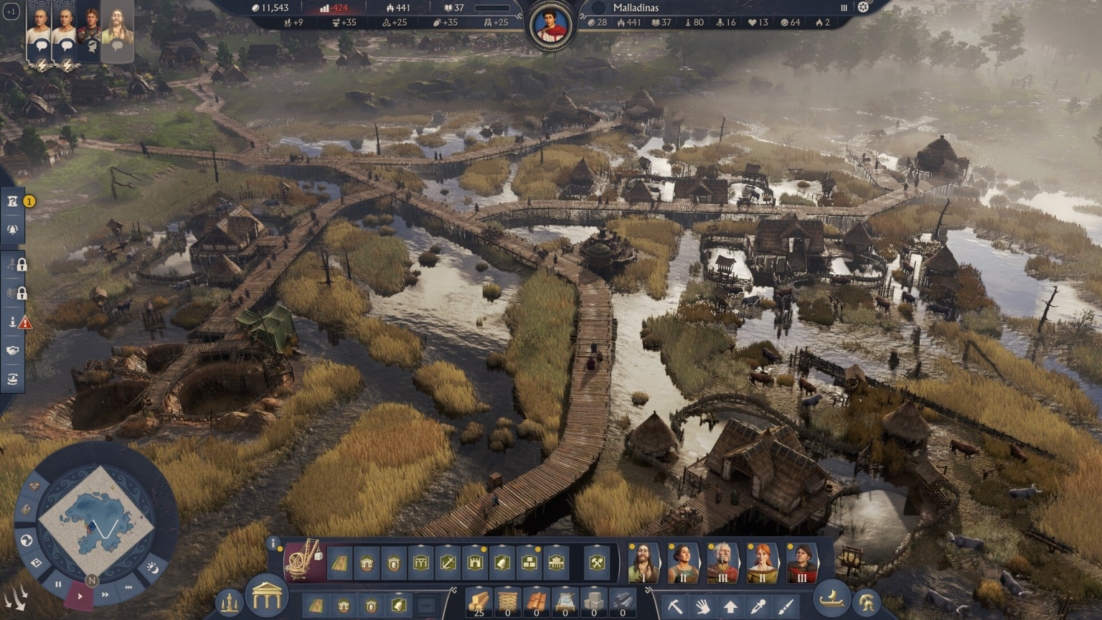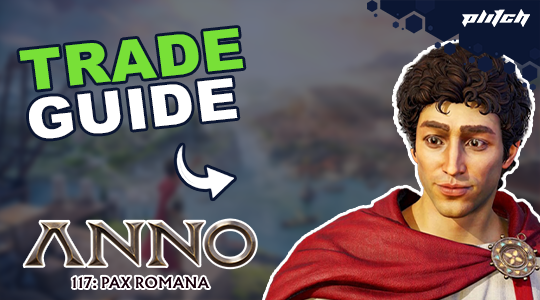Building a Roman province seems peaceful until your city suddenly catches fire, your workers riot, and your supply chains break down. Our Anno 117 tips and tricks show you how to expand your settlement, keep your people happy, and avoid the common early game mistakes that can ruin even the most promising empire.
Table of Contents
Choose a Region
Your first big decision in Anno 117: Pax Romana comes when you hit Start. The game offers two provinces, and each one plays completely differently. The choice determines how tough your early hours will be, so choose carefully.
If this is your first time with the series, start with the campaign. It functions like a long guided tour. You learn every core mechanic while building your first settlements, trading, and managing your people’s needs. It is relaxed, structured, and great for understanding the basics.

If you want complete freedom instead, choose Endless Mode. In that case, your region choice becomes even more important.
- Latium offers an easy start. It has plenty of room to build, rich soil, and stable politics. You deal with just one culture and can focus on growth without constantly putting out fires. It’s perfect if you want to relax and expand at your own pace.
- Albion is the wild north. Marshlands restrict where you can build and force you to think carefully before placing anything. Even your population chooses a different path. You decide whether your Waders follow Celtic traditions and become Smiths or switch to a Roman lifestyle and turn into Mercators. Both choices create different production chains and needs.
Managing both cultures simultaneously is doable, but expect a challenge. You’ll handle two sets of demands and two completely different supply chains. If you enjoy optimizing everything, go for it. If not, keep things simple and focus on one path.
Anno 117 Building Tips
Start With the Basics
At the beginning of Anno 117, keep it simple. You only need a small, stable core.
Build in this order:
- Roads first
- Connect everything with clear road lines
- Every building needs a road to move goods
- No road means no deliveries and no production
- Woodcutters and Carpenters
- Place woodcutter huts in dense forests (aim for 100 percent trees)
- Put the carpenter right next to them
- Boards are your early game lifeblood
- Fishing huts
- Sardines keep your people fed and calm
- Build two fishing huts close to the coast
- Make sure they are connected to roads and a warehouse
- Warehouses
- Warehouses send out carriers to collect goods
- Place them so they cover wood, food, and key industries
- No warehouse nearby means your storage stays empty
Build Smart Housing Districts
A few simple rules:
- Build organized residential blocks instead of random chaos
- Use a straight grid so roads are easy to extend
- Keep one broad middle strip open for service buildings
A solid early layout:
- Leave a main street open at the center
- On both sides, line up long double rows of houses
- Houses placed side by side, compact and efficient
This saves you a lot of rebuilding later when services and upgrades arrive.
Build Wide, Not High
Here’s the big trap in Anno 117: upgrading too quickly. When you upgrade a Liberti house to Plebeian level, you lose that Liberti worker. Upgrade too many houses, and suddenly:
- No one cuts wood
- No one works in warehouses
- Your economy collapses in seconds
So, follow this rule:
- Fill the entire service radius of a market with Tier One houses
- Get a big, stable income from basic workers
- Only upgrade a few houses at a time when you have excess workforce
Your service buildings in Anno 117 have fixed maintenance costs. The more houses they cover, the more taxes you can collect from them. That is why you build wide first, not tall.

Before you upgrade anything, always check the workforce panel near your player icon. If your available workers count is low or red, stop upgrading.
Use Building Effects to Your Advantage
Almost every building in Anno 117: Pax Romana affects your city stats. Some boost them, others harm them.
Good examples:
- Spinner
- Increases the income of buildings in its area
- Place it in the middle of dense housing blocks for a big money boost
- Dairy
- Raises happiness for nearby buildings
- Great in busy neighborhoods that demand mood swings control
Bad neighbors:
- Charcoal burners
- Lower health and fire safety around them
- Build them far away from housing and key industry
Then there is City Watch. Three buildings you should use in every big town:
- Vigiles for fire safety
- Medici for health
- Custodes for happiness and order
They also send first responders during fires, riots, or disease outbreaks. Just remember: they only assist if other buildings are within their range.
When you position these buildings in Anno 117, observe the arrows:
- Green arrow up means a positive effect
- Red arrow down means trouble
Your goal is straightforward. Maximize green, and push the red far outside your main districts.
Plan Your Layout
Don’t just spam roads and houses in Anno 117. You’ll regret that mess later. Try this approach:
- Create a broad main street through the center
- Place service buildings like Market, Tavern, and Grammaticus along that line
- From there, build housing blocks in a T shape that stretch out into the land
This T-shaped layout services more houses within each radius. You receive greater value from every service building.
And don’t forget the planning mode:
- Use blueprint mode to draw future districts
- You can place buildings you haven’t unlocked yet
- This avoids awkward gaps and random rebuilds later
Upgrade Your Roads ASAP
Once your city expands in Anno 117 and reaches population tier three, a new essential resource becomes available: concrete. Do this as soon as possible:
- Set up concrete production and stock up
- Once you have around five stacks, open the research tree
- On the economic branch, after “Warehouse Organization”, research “Paved Roads”
- Use the upgrade tool to convert dirt roads to paved roads
Why this is huge:
- Paved roads extend building range
- Carts move faster, which boosts production speed
- Almost every supply chain in your empire runs smoother
Anno 117 Tips: Which Needs to Fulfill
Your empire in Anno 117: Pax Romana only grows if your people stay happy. Each population level has its own needs, and the higher you go, the more intricate the supply chains become. You begin with Liberti, who keep things simple, but soon your city turns into a complex production puzzle.

Early Game Needs
Your first residents only ask for two essentials:
Oatmeal
- Build two oat farms. Each farm needs eighty fields, so leave enough room.
- Place two kitchens nearby. They turn grain into oatmeal.
- Oatmeal boosts population growth and gives stable early income.
Tunics
- Build two hemp farms with sixty fields each.
- Add two spinners, which process the hemp into tunics.
- Tunics keep your Liberti satisfied and unlock tier progress.
You’re not required to meet every single need. However, fulfilling more needs results in higher income, increased population, and quicker progress.
Optional bonus for Liberti:
- Wool hats
- Requires sheep farms
- Sheep are also needed later for shipbuilding
- Producing wool hats now gives profits later
You Choose How Your People Eat
To guide Liberti toward becoming Plebeians in Anno 117, you only need a few essentials like sardines, tunics, and a market. Everything else is optional, but can be profitable.
For food production, you can pick one or combine both:
- Sardines: Gives +1 population and +1 income
- Porridge: Gives +2 population
If you produce both, your bonuses stack. More people mean more taxes and expansion. But again, it is your call.
Tier Two Needs
Food options
- Bread: Wheat farm, Mill, Bakery
- Garum: Mackerel, Salt, Mixed into fish sauce
Goods options
- Sandals: Pig farm, Salt Garden, Tannery, Clothier
- Soap: Pig farm, Tallow chandler, Soap boiler
You only need one option in each category to move forward. Offering both just makes you wealthier.
Don’t Upgrade Everyone at Once
Before you promote half your city in Anno 117, check your workforce numbers at the top of the screen. Every production building needs workers from a specific tier. If you upgrade too quickly:
- Your Liberti disappear
- Woodcutters stop working
- Warehouses stop collecting
- Production stalls everywhere
This is how cities die.
Upgrade gradually. Ensure enough tier one workers survive to support and sustain your industries. A balanced workforce keeps your city functioning and your income steady.
How to Avoid Catastrophes
Your city might seem peaceful, but Anno 117 thrives on chaos. Fires, diseases, and riots will try to tear your settlement apart the moment you lose focus. The key is preparation.
Build Your Safety Net Early
Don’t wait for disaster. Build your core service buildings before your population explodes. You need three essentials:
- City Watch: Monitors unrest and prevents crime before it spreads.
- Firefighters: Prevent your settlement from becoming a Roman barbecue.
- Doctors: Contain diseases and prevent entire communities from falling apart.
Leave space in your housing districts for these buildings. If your city is too crowded, you’ll have trouble deploying emergency services when they are most needed.
Watch Your Risk Buildings
Some buildings pose natural dangers in Anno 117. A typical example is the Bakery, which has a high fire risk. Avoid placing these buildings right in the middle of dense housing. Instead, put them slightly away or in zones covered by your fire department.

As your city grows, the fire risk increases quickly. Especially on higher difficulties, you might see a fire every other minute if you ignore safety. That’s not a big deal if you prepare, but it can be disastrous if you don’t.
What to Do When Disaster Hits
If a fire breaks out, do this:
- Pause the game: You buy yourself valuable time to react.
- Use the relocation tool: Move nearby intact buildings away from the flames. This prevents the fire from spreading across entire blocks.
- Let firefighters handle cleanup: You might lose some buildings, but that’s normal. They can be rebuilt.
The same applies to sickness and unrest. As long as your City Watch and Doctors are nearby, they will send responders right away.
Keep Your Finances Healthy
Every production building in Anno 117 costs money. Building too many quickly can leave you broke. Getting a loan from another leader can help, but it has interest and can become costly fast.
Instead, stabilize your income through Liberti:
- Fulfill their extra needs
- Keep plenty of tier one residents
- Enjoy steady tax income that cushions every disaster
A wealthy city endures disasters. A poor city burns to the ground.
Supply Chains and Production Lines
A strong Roman city in Anno 117 runs on smooth production. If one link in the chain breaks, the entire economy feels it. Understanding processing times, ratios, and resource flow is what transforms a struggling village into a wealthy province.
Learn How Production Chains Actually Work
Every resource in Anno 117 is produced through a chain of buildings. When you click on an end product like timber, porridge, or tunics, you can see every step that contributes to its creation.
Hover over a product to see the processing time. That number shows exactly how many buildings you need for a perfect, balanced chain.
An easy example:
- Woodcutter produces wood every 30 seconds
- Sawmill turns wood into timber in 30 seconds
Perfect 1-to-1 balance. One woodcutter supports one sawmill. No waste. No shortages.
Expansion is required

Your starting island in Anno 117 will never have all the resources. Lavender, tallow sources, and other fertility spots will force you to expand. Do it like this:
- Load a ship with planks and tiles
- Sail to a new island with the missing fertility
- Build a trading post
- Start your new production lines there
But expansion costs money and requires ongoing maintenance. Choose new islands that truly fill a gap in your supply chains. Don’t expand just because you can.
How to Avoid Trade Route Disasters
Here’s a common mistake in Anno 117: you set up automated trading and watch your trade ship take every last plank from your main island. Then your home construction halts, and your entire city comes to a standstill. To prevent this, click on your Trading Post and set a minimum stock level.
This means:
- The trade ship will not take resources below that threshold
- Your home island always keeps enough planks for building
- Your colony still receives what it needs
- Your economy doesn’t get sabotaged by your own trade route
This menu in Anno 117 also enables you to automatically sell surplus goods to AI traders. Once your production lines stabilize, it provides a steady passive income.
Grow Your Empire Faster With PLITCH!
If you want to focus on building the perfect Roman province without constant resource shortages, PLITCH provides you with powerful tools. Our Anno 117 codes let you experiment, optimize, or simply enjoy city-building at your own pace.
With Add Credits and Sub Credits, you manage your budget instantly. No more waiting for tax income to arrive before building that next warehouse or workshop. If you want to boost your economy, the research multiplier accelerates upgrades and tech development so your empire reaches paved roads and advanced production much sooner.
For pure comfort, All Needs Fulfilled turns your city into a stress-free paradise. Your residents stay happy, productive, and ready to advance no matter what. It is perfect if you want to focus on layout, design, and large-scale empire planning.
If you want to learn more about PLITCH, check out this blog and our YouTube channel.
Happy Gaming!
Check out our other Anno 117 guides:


